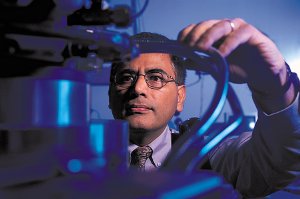Jul 19 2009
Newly announced National Institutes of Health (NIH) funding will expand the reach of ongoing University of Alabama at Birmingham (UAB) research into a unique nanostructured coating to improve the performance and longevity of total joint replacement components. The broadened UAB research opportunity is funded by a four-year, $790,931 National Institutes of Health (NIH) grant through the National Institute of Arthritis and Musculoskeletal and Skin Diseases (NIAMS).
 Yogesh Vohra.
Yogesh Vohra.
UAB's research, titled Bioengineering Research Partnership (BRP) in Total Joint Replacements, will explore next-generation technology to improve the service life of total joint replacements, which UAB researchers believe could dramatically cut the number of recurrent surgical procedures performed each year, said Yogesh Vohra, Ph.D., the BRP's principal investigator and director of the Center for Nanoscale Materials and Biointegration (CNMB) in the UAB School of Natural Sciences and Mathematics.
Vohra said the BRP opportunity will unite his UAB interdisciplinary research team with professionals at Smith and Nephew Inc., an international leader in the development of advanced medical devices. The company is known globally for its OXINIUMTM oxidized zirconium material for joint replacements.
"We have been researching our nanostructured multilayer diamond coating for a number of years inside our UAB facilities but there have been limitations to just how rigorous the testing could be," Vohra said. "The funding to partner with Smith and Nephew expands our research options because it offers us access to the company's resources and talent."
Among the benefits, Vohra said, the BRP allows access to Smith and Nephew's hip and knee simulators, which offer UAB researchers the most realistic testing conditions to date for their coating technology. Working with the multi-million dollar simulators should strongly indicate how well the team's nanostructured multilayer diamond coatings reduce the friction and wear on the metal components of orthopaedic devices, Vohra said. The team also will be able to examine the cellular and tissue responses to the technology and confirm that there is no toxicity effect from any wear debris that is generated.
"This partnership is central to advancing our research toward more reliable and efficient joint replacements," Vohra said. "We are gaining access to state-of-the-art testing equipment while benefitting from Smith and Nephew's experience as the industry leader in advanced bearing-surfaces for joint replacement implants."
The BRP also helps put the UAB coating technology on the fast track for commercialization, as it will foster the private industry relationship necessary to secure investment and production capacity, Vohra said.
The overall clinical impact of the BRP research is to drive down the number of recurrent surgical procedures for joint replacement recipients, who are living longer and pushing the longevity limits of their devices, Vohra said. The American Academy of Orthopaedic Surgeons reports that 15 to 20 percent of annual total joint replacement procedures are recurrent, or revision, surgeries. Vohra said the nanostructured diamond-coated devices should reduce the metal ion release to the surrounding tissues and perform better during long-term implantation in the human body, which could significantly cut the follow-up surgery rate.
The UAB interdisciplinary research team for the project includes Vohra, Susan Bellis, Ph.D., associate professor of physiology and biophysics, Aaron Catledge, Ph.D., research assistant professor of physics, Alan Eberhardt, Ph.D., associate professor of biomedical engineering and David Moore, M.D., Division of Orthopedic Surgery.